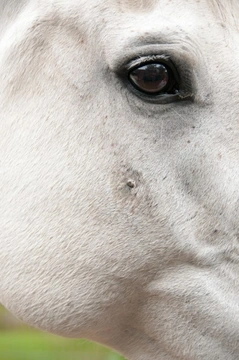
Sarcoids and should you remove them
The mention of the word ‘sarcoid’ invokes some quite strong reactions from horse owners. At purchase, a sarcoid is something that doesn’t trouble some buyers and will cause others to walk away. If the horse is vetted, sarcoids will usually be noted on the vet certificate and then excluded by the insurance company.
Sarcoids, some key facts
Sarcoids are skin tumours and develop on horses mainly around the head, in the axilla - essentially the armpit - and the groin area so between the hind legs up underneath the tail. They can also develop in wounds where they can be mistaken for proud flesh.
- Sarcoids are called fibrosarcoma and are locally invasive and do not spread to other organs
- Sarcoids are the most common skin tumours in horses accounting for 40% of equine cancers
- Sarcoids affect mares and geldings and all breeds and ages
- Sarcoids do not self-cure and will often multiply
Causes of sarcoids
Sarcoids are caused by the bovine papillomavirus or BPV, however, not all horses exposed to the virus develop sarcoids so the ones that do are thought to have a pre-disposing genetic susceptibility.
The susceptibility does not reduce so horses which have already had sarcoids may get them again; this is because the virus becomes embedded in the DNA of infected skin cells.
Can sarcoids be spread from horse to another by direct transmission?
It is possible although there is no definitive scientific conclusion that sarcoids will pass via direct horse to horse contact or be spread by flies.
The diagnosis of a sarcoid
Sarcoids can present in a range of different ways as there are several types with different levels of aggressive behaviour. Before any treatment can be considered, the vet needs to identify which type of sarcoid the horse has. Inappropriate treatment can make the sarcoid worse and it can return in an even more aggressive form making subsequent treatments much more difficult.
The vet will not usually carry out a biopsy as all sarcoids present in a similar way under the microscope and biopsy can make sarcoids more aggressive.
Different types of sarcoid
Verrucose – these are slow-growing flat, scaly tumours and look like small scars or ringworm, these are the least aggressive sarcoid type
Nodular – these are clearly defined, well-demarcated lumps which are covered by normal skin. Nodular sarcoids are prone to ulceration and have a medium growth rate
Fibroblastic – fibroblastic tumours are aggressive sarcoids which grow rapidly and are locally invasive into the tissues underneath the skin. They often appear in clusters and are variable in size and shape because they grow rapidly
Occult sarcoids appear as roughly circular hairless areas or even appear as skin which has an altered hair quality. Sometimes the only change may be a difference in the coat colour
Mixed sarcoids – mixed sarcoids are a combination of verrucose, nodular and fibroblastic and it is not unusual to for horses to develop clusters of mixed sarcoid types
Treatment options
There is no one prescribed treatment for sarcoids and what the vet recommends will depend on the identification and appearance of that particular sarcoid. Other factors which will determine the appropriate treatment option include:-
- The location of the sarcoid
- The extent of the sarcoid
- Treatment cost
- The horse’s temperament
Medical interventions include injecting the immune stimulant Bacillus Calmette Guerin (BCG) vaccine directly into the sarcoid. There are also injectable chemotherapy drugs which act by interfering with the DNA copying process in the cells.
There is a topical cream option known as ‘Liverpool cream’ has it was pioneered by a well-known vet at the University of Liverpool. This cream has to be applied by a vet so may require several visits to the affected horse at set intervals.
There is a photodynamic treatment which involves applying a chemical to the surface of the tumour and then exposing it to a certain type of light which activates the chemical to kill the tumour cells.
Surgical interventions include excision or removal, cryosurgery (freezing off) or laser surgery. Sometimes surgery has to be combined with another therapy.
Benign neglect is also a possibility – do nothing slowly – and vets differ in their opinions on this; much will depend upon the size and type of the sarcoid and where it is located.
Sarcoids present at purchase
The presence of a sarcoid is not usually a reason to fail a horse on a five-stage vetting but any insurer will exclude the costs of future sarcoid treatment from insurance cover. A horse which develops a sarcoid will usually have those costs covered under a vets fees policy but payments will only be made for 12 months before sarcoids are then excluded from the cover.
How much the treatment costs will depend entirely on the type of treatment and the number of sarcoids but will run into thousands of pounds over the course of months and years.
Sarcoids typically invoke an extreme response from horse owners, some just don’t care whereas others are very adverse to having a horse with a sarcoid; a lot can depend on prior experience and knowledge. A horse presented for sale with a sarcoid may typically have a discounted price but not always.



